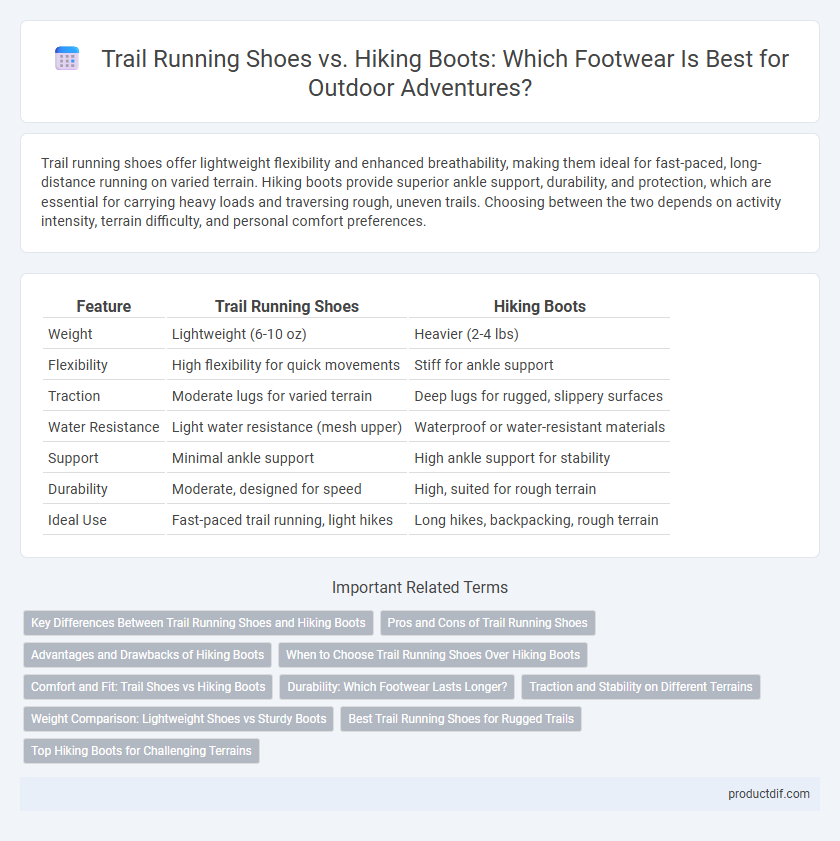Trail running shoes offer lightweight flexibility and enhanced breathability, making them ideal for fast-paced, long-distance running on varied terrain. Hiking boots provide superior ankle support, durability, and protection, which are essential for carrying heavy loads and traversing rough, uneven trails. Choosing between the two depends on activity intensity, terrain difficulty, and personal comfort preferences.
Table of Comparison
| Feature | Trail Running Shoes | Hiking Boots |
|---|---|---|
| Weight | Lightweight (6-10 oz) | Heavier (2-4 lbs) |
| Flexibility | High flexibility for quick movements | Stiff for ankle support |
| Traction | Moderate lugs for varied terrain | Deep lugs for rugged, slippery surfaces |
| Water Resistance | Light water resistance (mesh upper) | Waterproof or water-resistant materials |
| Support | Minimal ankle support | High ankle support for stability |
| Durability | Moderate, designed for speed | High, suited for rough terrain |
| Ideal Use | Fast-paced trail running, light hikes | Long hikes, backpacking, rough terrain |
Key Differences Between Trail Running Shoes and Hiking Boots
Trail running shoes prioritize lightweight design and flexibility to enhance speed and agility on varied terrains, while hiking boots provide superior ankle support and durability for extended treks and rugged conditions. Trail running shoes feature aggressive tread patterns for grip on slippery and uneven surfaces, whereas hiking boots incorporate sturdier soles and reinforced materials to protect against rocks and debris. Breathability and quick-drying fabrics in trail running shoes contrast with the waterproof membranes and insulation found in hiking boots, highlighting their distinct roles in outdoor performance.
Pros and Cons of Trail Running Shoes
Trail running shoes offer lightweight design and superior breathability, enhancing speed and comfort on varied terrain compared to heavier hiking boots. Their flexible soles improve agility and reduce fatigue, but they provide less ankle support and durability, increasing the risk of injury on rough or uneven trails. Ideal for fast-paced runners seeking agility, trail running shoes may lack the protection and stability required for extended or rugged hikes.
Advantages and Drawbacks of Hiking Boots
Hiking boots offer superior ankle support and durability, making them ideal for rugged terrains and extended backcountry trips where stability and protection against sharp rocks or uneven surfaces are critical. These boots generally provide better waterproofing and insulation, which helps maintain comfort in wet or cold environments but can result in increased weight and reduced breathability compared to trail running shoes. However, the sturdier build and heavier materials can lead to faster fatigue during long-distance or fast-paced activities, limiting their suitability for speed-focused trail running.
When to Choose Trail Running Shoes Over Hiking Boots
Trail running shoes are ideal for fast-paced, lightweight activities on well-maintained or moderately rugged trails, offering superior breathability, flexibility, and cushioning compared to hiking boots. Choose trail running shoes when prioritizing speed, agility, and comfort on shorter or less technical routes, especially in dry or warm conditions. For extended hikes, rough terrain, or heavy backpacks, hiking boots provide better ankle support, durability, and protection against debris.
Comfort and Fit: Trail Shoes vs Hiking Boots
Trail running shoes offer lightweight design and flexible soles that provide superior comfort and a snug fit for dynamic movements on varied terrain. Hiking boots feature robust ankle support and thicker padding, ensuring stability and protection but often sacrificing breathability and immediate comfort. Choosing between the two depends on prioritizing agility and a close fit versus enhanced support and durability for prolonged wear.
Durability: Which Footwear Lasts Longer?
Trail running shoes feature lightweight materials designed for speed and flexibility but generally wear out faster due to thinner soles and less robust construction. Hiking boots are built with durable leather or synthetic uppers and reinforced soles, providing superior longevity and resistance to rough terrain. For extended use over rocky, uneven surfaces, hiking boots offer greater durability compared to trail running shoes.
Traction and Stability on Different Terrains
Trail running shoes feature aggressive outsole lugs designed for superior traction on varied terrains such as rocky paths, loose gravel, and muddy trails. Hiking boots offer enhanced stability with a sturdier sole and ankle support, providing reliable footing on uneven and rugged landscapes. Both prioritize grip, but trail running shoes excel in lightweight agility while hiking boots maximize protection and steadiness on challenging ground.
Weight Comparison: Lightweight Shoes vs Sturdy Boots
Trail running shoes typically weigh between 6 to 10 ounces, offering superior agility and reduced fatigue over long distances. Hiking boots can weigh from 2 to 4 pounds, providing enhanced ankle support and durability for rugged terrain. Choosing lightweight shoes improves speed and comfort, while sturdy boots excel in protection and stability.
Best Trail Running Shoes for Rugged Trails
Best trail running shoes for rugged trails offer lightweight durability, enhanced grip, and superior cushioning tailored to uneven terrain. Key models feature Vibram outsoles for rugged traction, breathable mesh uppers for moisture control, and reinforced toe guards for protection against rocks and roots. Brands like Salomon Speedcross, Altra Lone Peak, and Hoka One One Speedgoat lead in combining agility with rugged trail resilience.
Top Hiking Boots for Challenging Terrains
Top hiking boots for challenging terrains feature rugged outsoles with deep lugs, providing superior traction and stability on uneven surfaces. Constructed with durable, waterproof materials like Gore-Tex, these boots offer reliable protection against moisture while maintaining breathability. Enhanced ankle support and reinforced toe caps ensure safety and comfort during extended treks through rocky or muddy landscapes.
Trail Running Shoes vs Hiking Boots Infographic

 productdif.com
productdif.com